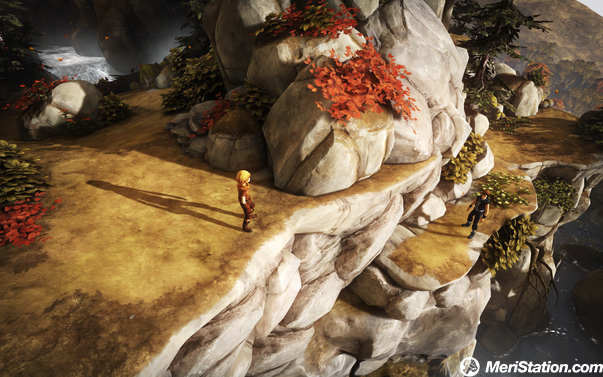“Legends are Lessons that convey truths”
A sky lacking in its characteristic blue is the initial small statement of intent with whichStarbreeze Studios – authors of the accomplished Chronicles of Riddick: Butcher Bay – opens its fraternal fable. A panoramic plane that reveals a child kneeling
before the grave of a loved one he lost. The dream is interrupted by the older brother, who calls him to return to the same sad reality, and help him through a first scenario that involves contact with ICO mechanics of puzzles and interaction between both characters.
Dealing with death is the initial theme of the story, because our father dies, and only a plant that grows on top of the distant mountain will serve to remedy it.
As we see, the classic starting point of a fable, or a fantasy story, especially taking into account the enclave in which the two protagonists move, with Celtic and Nordic air,
Brothers: A Tale of Two Sons opens the Summer of Arcade 2013 and also (later) to Steam and PSN with a beautiful story that, like other experiences like The Unfinished Swan , the works of thatgamecompany ,
Limbo and other titles already consecrated, demands to be carried away by it to enjoy as much of the narrative as of all that Starbreeze wants to offer us in a too condensed duration, which is and becomes very short, unfortunately, only about 3 or 4 hours .
As has happened on other occasions, we enter the delicate terrain of duration, although the fraternal journey we are going through deserves considerable dramatic, emotional and playable.
Yggdrasil
The best example of the simplicity of the gameplay of Brothers we have when we enter the section How to Play from the initial menu, which does not detail actions, or possibilities, or what one brother or another is able to do, but simply and simply that a stick and a trigger of the pad belong to each of the characters:
With the sticks we move them, with the triggers they interact with the world around, so simple and simple. A playable minimalism designed to maximize feelings.
We can go without stopping to see anything, or we can go interacting with everything that surrounds us, leaving us permanently the game of how different it is to perceive the world with one or another character.
If a door is closed, the older one will call with his hand, while the younger one will start kicking; if they let us hold a cat puppy, with the older one it will be a bunch of nerves, while with the younger one it will calm down and even purr.
The interaction between both and the world around them is absolute and constant, with a variety of Hotspots / points of interaction in each corner of the scenarios as numerous as in a graphic adventure, whether they are essential to advance, secondary or simply retailers without further , to help, smile or simply contemplate, but with the component that none of these is highlighted.
And this is one of the added that gives an account of the degree of experimentation that the study has led cabre with this little work: The fact that nothing is signaled beyond explaining some very basic things. We will discover the actions mostly visually and using reason, observing the scenario: a rope wound here, a ledge there, a gate through which to sneak.
All this simply using our eyes and, considering the roles: the older brother, stronger, and the younger, weaker but more agile. And without time, without any mini-map, without any arrow of objectives. Nothing.
A very risky bet of the study without a doubt, but a joy for the player who is fed up with corseted experiences that tell us where to tighten or move constantly.

